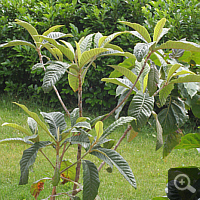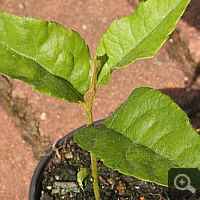Loquat (Eriobotrya japonica)
Overview
The Loquat originates in central China and Japan. It is particularly popular in Italy, where you can often buy them under the name ‚Nespoli‘. The Loquat belongs to the Rose family (Rosaceae) and is not closely related with the Common Medlar (Mespilus germanica).
Description
Loquats are small trees with a good branching. Up to 30 cm long, elongated, slight churlish, rough and dark green leaves are produced. Young leaves are light green. They get darker considerably within a few weeks. Plants are frost-hardy up to -8°C. However, also in favourable sites it is not appropiate to plant out the plants because flowers are produced in autumn and winter. From these evolve circa apricot-sized, delicious fruits, which mostly cotain one to three large seeds in the mid. Fruits are suitable both fresh consumption and processing.
Culture
It is relative difficult to get seeds. The best bet is to bring them with you from your next holidays in Italy. The seeds germ within three to four weeks nearly to hundred per cent. Further culture is simple. Relative quickly growth with good spontaneous branching. Until mid-October outdoors, slight frost is well tolerated. Then at a light place, because the plant shows no decituation. However, the place can and should be indeed cool.
Experiences
The Loquat is also for botanical not interested parties a worthwhile object. The plant is undemanding and likewise a splendid pot plant with a fresh, vigorous aspect. Propagation from seeds is not difficult. It requires patience (germination time circa four weeks) and some instinctive feeling in watering (seeds sensitive to waterlogging). Then the plant shows a slight quick and continuous growth. Branching begins reliable spontaneously. Within four to five years Loquats can grow up to a multi-branched, head-high tree. Overwintering is not difficult. Cool and light location. Water demand is low. With watering can you can wait until leaves gradually begin to hang down slackly. After watering plants recover within hours.
2008
The seeds, I had from Italy, germed within a few weeks. Further growth was satisfying. At the end of the year the small plants reached a height of 15 cm.
2009
During winter, I cultivated the small plants under warm conditions. The plants showed a good growth during summer. At a height of 40 cm spontaneous branching started.
2010
For the first time I overwintered my plant cool and light. This pleased the plant obviously. In spring several new branches were built. At the end of the year the plant reached a height of 80 cm.
2011
I overwintered my plant cool, rather dark and quite dry this year. The plant came through overwintering undamaged and sprouted well, as soon as it stood outdoors.


